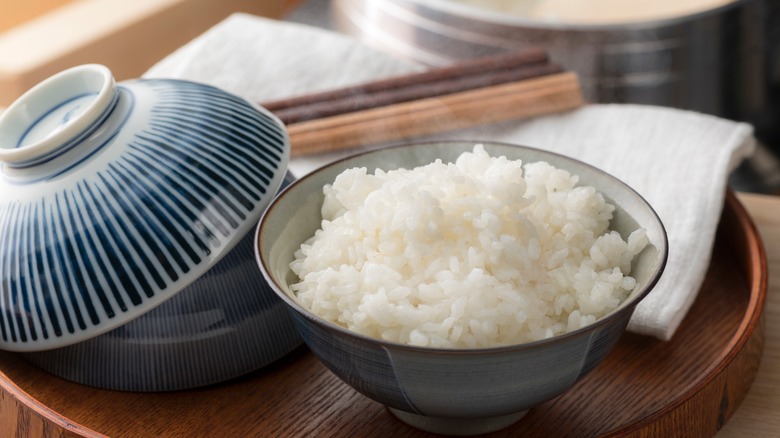Here's The Best Way To Store Cooked Rice (And How To Reheat It Later)
From vegan tofu stir fries to sushi rolls and decadent puddings, there are seemingly endless ways to incorporate rice into both savory and sweet dishes. The only downside to this classic grain is that, whether you cooked it on your stove or ordered takeout, you'll often have leftovers. However, you should think twice before you eat leftover rice if you haven't properly stored it.
Uncooked rice can contain spores of Bacillus cereus, a microorganism that is often present in the soil where rice is cultivated. Although cooking Bacillus cereus-infected rice can kill much of the bacteria, some spores may linger. If the rice cools too long at room temperature, the spores can multiply, making it unsafe for consumption. Because rice is a grain often grouped with other nonperishable foods like pasta or dried beans, you might assume it's handled similarly. However, because cooked rice is moist, it provides an ideal environment for bacteria to grow if not kept properly. Cooked rice should be swiftly served, and any leftovers stored in the refrigerator in an airtight container at temperatures below 40 degrees Fahrenheit. To hasten cooling, transfer the rice to your containers immediately.
To reheat rice to its freshly cooked form, water is key – 1 to 2 tablespoons of water or broth for every cup of rice can revive it. Just microwave each batch in a covered bowl or steam the grains on the stove in a covered pot, stirring occasionally until it's thoroughly heated and fluffy.
How long properly-stored leftover rice lasts
Storing leftover rice in the refrigerator as soon as it reaches room temperature is essential for preserving its freshness for later consumption. However, even when properly stored, leftover cooked rice is only safe to eat for up to four days. If you can't eat the rice within that time frame and want to reduce food waste, you can put your leftover grains in the freezer, where they will last for around two months. To cook frozen leftover rice and keep it fluffy, thaw overnight in the refrigerator and follow the previously outlined steps for reheating.
Knowing when it's time to say goodbye to your leftover rice is critical for avoiding illness-causing bacteria. If the rice takes on a sour or rancid smell, toss it. Similarly, if it develops a slimy texture, it's time to replace your refrigerated rice stash. Visual signs of mold or any other organic growth on the leftover rice are obvious indicators that you should throw it out. If mold made its way onto the food container, wipe it out with a paper towel and soak the container in a bleach-water solution.
Rice is a cross-cultural ingredient used in many different cuisines, and it deserves proper storage to maintain its integrity. As long as you are keeping it properly, however, you can get the most out of your leftovers.

